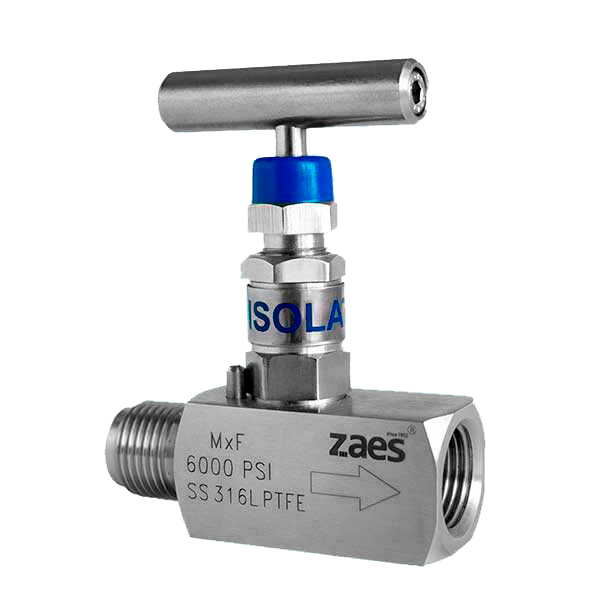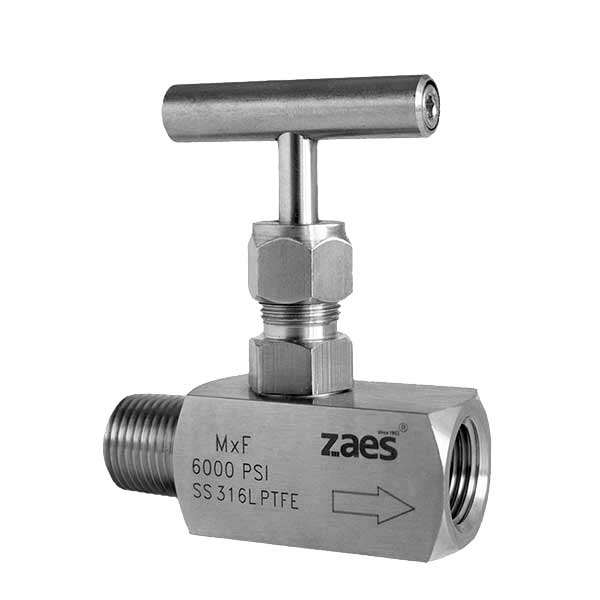What is a
needle valve
A needle valve in stainless and other alloys are valves that can be used to regulate the flow of a substance (generally needle valves for gas or needle valves for water) through an apparatus or system. The unique feature of this value is that it contains a small needle-shaped plunger (as the name suggests).
Needle valves in stainless and other alloys get their name from a tapered stem, which acts as a plug in a small diameter hole related to the nominal diameter of the valve.
The movement of the valve stem, if it is a fine thread, is slow, in fact, the part of the fluid passage is not the smallest until many turns, due to its stability this valve becomes a good flow regulator. The precision plug design favors a good metal seal, with little wear and can prevent cavitation in case of high pressure differences.
You can find designs that have the valve inlet and outlet ports in angular, straight (90º), or linear (0º) shapes.
Features and functions
of a needle valve
Needle valve is a well known type because it is commonly used in industrial facilities. It has a tapered stem / shaft that can partially open, close, or block conduits or holes. It is relatively small and therefore suitable for any pressure system with previous dimensions.
Like other types, the purpose of this needle valve is to effectively and safely regulate the fluid flowing through the circuit. Its name comes from its design, as it has a tapered stem / shaft that serves as a plug for the hole, and its diameter is very small compared to the nominal diameter.
If in this type of industrial needle valve, the valve stem has fine threads and the travel is very slow. Also, the cross section of the fluid channel before turning is small, which makes it an excellent choice for regulating flow.
What types of needle valves are there
At Zaes, as needle valves manufacturer , for more than 60 years, we guarantee a quality product for your installations .
Needle valves applications are commonly used in high- and low-pressure hydraulic systems, chemical processing, and other liquid and gas applications. Depending on their materials, they can also be used in oxygen or high temperature systems.
They are usually made of AISI 316 L stainless steel, carbon steel, Monel, Inconel, Hastelloy, duplex steel, and super duplex steel. It should be added that they must consider the most suitable material for their application, which will help them to extend the life cycle of the valve and keep the system safe and active for a long time.
Needle Valves Operation
- Adjust the flow rate by turning the knob. If you rotate clockwise, the flow rate decreases, and if you rotate counter-clockwise, the flow rate increases.
- Close the valve with manual force only. Use pipes or keys for no reason.
- If the valve is at high temperature, be aware that you may burn your hands during operation.
- In the actuating valve, the mechanical integral actuator sends an open or close signal.
- Do not leave the valve stationary for a long time. It is recommended to run it regularly to ensure its correct and continuous operation.

In the needle valve, the distance between the valve seat and the piston can be controlled by the handwheel / lever. They have very thin threads so they move very slowly and require multiple turns to fully open. This allows the needle valve to have high stability, precision and tightness, as well as having anti-aging properties by avoiding vacuum suction under high pressure differences.
This makes them ideal for protecting sensitive instruments and equipment from damage that can be caused by sudden pressure changes. They are generally used in systems that process materials with lower viscosity, lower weight, and lower flow rates.
